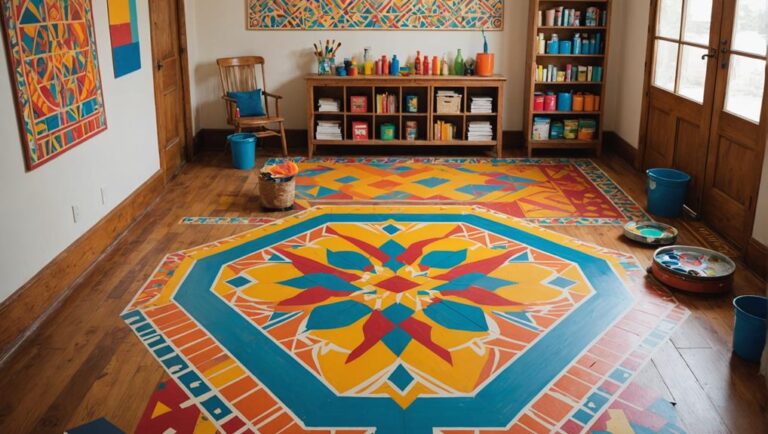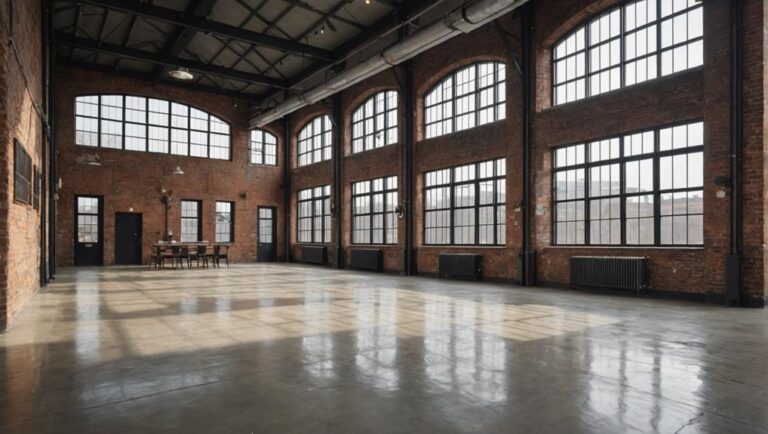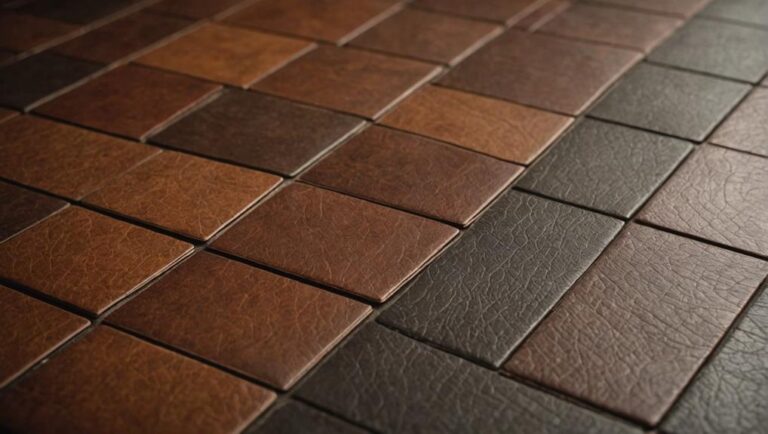Soundproofing floors in shared apartments is key to fostering tranquility. You can start by using thick carpets or rubber flooring to absorb sound and dampen vibrations. Investing in high-quality underlayment beneath any hard surfaces makes a noticeable difference. Simple DIY techniques, like placing acoustic panels or adding area rugs, can also help. If you're up for it, sealing gaps around doors and windows boosts the effectiveness of your efforts. These changes not only reduce noise but also enhance your comfort and relationships with neighbors. Keep exploring, and you'll uncover even more strategies to create your serene oasis.
Understanding Sound Transmission
When you live in a shared apartment, you might not realize just how easily sound travels between floors until the thud of footsteps or the murmur of conversations disrupts your peace. Understanding sound transmission is vital for creating a comfortable living space. Various impact factors contribute to this phenomenon, including the building's structure, the materials used, and even the height of your ceilings.
Sound travels in waves, and the frequencies of these waves play a significant role in how well they penetrate surfaces. Low frequencies, like those from bass-heavy music or heavy footsteps, can be particularly troublesome, as they easily pass through walls and floors. On the other hand, higher frequencies tend to be absorbed more readily, but they can still be disruptive when amplified by hard surfaces.
The layout of your apartment also affects sound transmission. Open floor plans may amplify noise, while closed-off spaces can create sound pockets, intensifying echoes. Consider how your neighbors' activities can reverberate through shared walls or floors, especially during late-night hours when you're trying to unwind.
To mitigate these disturbances, being proactive about your environment is essential. You can use area rugs to dampen sound or arrange your furniture in a way that helps absorb noise. Understanding these factors will empower you to take steps toward a quieter, more peaceful home, ensuring your shared living experience is as enjoyable as possible.
Materials for Effective Soundproofing
Choosing the right materials for soundproofing your floors can make all the difference in creating a serene living environment. You'll want to focus on materials that absorb and block noise effectively while ensuring safety and durability. Start by exploring various flooring options, such as carpet, which is excellent for reducing sound transmission. Its dense fibers can soak up vibrations, making it a preferred choice for shared apartments.
Another great option is rubber flooring. Not only does it provide a cushioned surface, but it's also resistant to moisture, which adds an extra layer of safety. If you prefer hard surfaces, consider engineered wood paired with high-quality underlayment designed for soundproofing. This combination can notably diminish noise from footfalls.
For additional sound control, think about installing acoustic panels along walls or ceilings. These panels can enhance your overall soundproofing efforts by absorbing sound waves that would otherwise bounce around your living space. They come in various colors and designs, allowing you to maintain your aesthetic while improving acoustic performance.
Don't forget to seal gaps and cracks around your floors and walls. Using acoustic caulk can prevent sound leaks, ensuring your soundproofing materials work effectively. By choosing the right combination of these materials, you'll not only create a quieter home but also enhance your living experience in shared spaces. With the right approach, you can enjoy peace and tranquility in your apartment, free from the disturbances of daily life.
DIY Soundproofing Techniques
Five effective DIY soundproofing techniques can transform your shared apartment into a quieter haven. Start by investing in quality floor underlayment. This dense material absorbs sound vibrations, making a notable difference when placed underneath your flooring. Next, consider adding acoustic panels to your walls. These panels not only enhance the aesthetics of your space but also considerably reduce noise transmission.
Another effective method is to use rugs or carpets. Thick, plush carpets can help absorb sound, especially in high-traffic areas. If you don't have wall-to-wall carpeting, layering rugs can be a great alternative. You might also want to seal any gaps around windows or doors with weather stripping. This simple step can block out noise and prevent drafts, creating a more comfortable environment.
Lastly, you can create a sound barrier by using bookshelves filled with books or other heavy items. This clever trick helps to dampen sound waves effectively. Here's a table summarizing these techniques:
| Technique | Description | Benefits |
|---|---|---|
| Floor Underlayment | Dense material under flooring | Absorbs sound vibrations |
| Acoustic Panels | Wall-mounted panels | Reduces noise transmission |
| Rugs/Carpets | Thick floor coverings | Absorbs sound, especially in traffic areas |
| Weather Stripping | Seals gaps around windows/doors | Blocks noise and drafts |
| Filled Bookshelves | Heavy shelves act as sound barriers | Dampens sound waves |
Professional Soundproofing Solutions
For those seeking a more thorough approach to soundproofing their shared apartments, professional solutions can make a considerable impact. While DIY methods can be effective, enlisting experts often brings about a level of quality and safety that's hard to achieve on your own. Professional services can provide tailored solutions that address your unique noise concerns, ensuring your living space becomes a serene retreat.
Here are some common professional soundproofing solutions you might consider:
- Acoustic Panels: These are specially designed to absorb sound waves, effectively reducing echoes and overall noise levels. They can be stylishly integrated into your decor, making them both functional and aesthetically pleasing.
- Sound Barriers: Heavy-duty materials can be installed between floors to block sound transmission. These barriers can considerably diminish upstairs noise, creating a quieter environment.
- Floor Underlayment: Professionals often recommend high-quality underlayment materials that act as additional cushioning between flooring layers, helping to dampen sound.
- Sealing Gaps: Experts can identify and seal any gaps around doors, windows, or baseboards, ensuring that sound doesn't sneak through unnoticed.
Investing in these professional soundproofing solutions not only enhances your comfort but also contributes to a safer, more peaceful living environment. With the right approach, you can create a haven where noise becomes a distant memory, allowing you to enjoy your shared apartment to the fullest.
Tips for Maintenance and Upkeep
When it comes to maintaining soundproofing measures in your shared apartment, regular upkeep is key to guaranteeing they continue to perform effectively. Start with floor care—keeping your floors clean and well-maintained can dramatically enhance your noise reduction efforts. Dust and dirt can accumulate in cracks or gaps, diminishing the soundproofing materials' effectiveness. Use a vacuum with a soft brush attachment to gently remove debris, and mop with a suitable cleaner to keep surfaces pristine.
Next, check for any signs of wear or damage. If you notice loose tiles or worn carpet, address these issues promptly. Repairing or replacing flooring not only improves aesthetics but also bolsters your soundproofing capabilities. Consider adding area rugs, which can absorb noise and contribute to a quieter atmosphere, especially in high-traffic areas.
Regularly inspect your soundproofing materials, like underlayment or soundproof mats, to guarantee they're intact. If you find any damage, replace these materials as needed. This proactive approach not only maintains your current setup but can also enhance your overall noise reduction.
Lastly, communicate with your neighbors about any noise issues they may experience. This fosters a respectful living environment and encourages everyone to participate in maintaining a peaceful home. By prioritizing these maintenance tips, you'll create a more serene living space that benefits both you and your shared apartment community.
Frequently Asked Questions
Can Soundproofing Floors Reduce Noise From Children or Pets Above?
If you're wondering whether soundproofing floors can help with noise from children or pets above, the answer is yes. By using effective noise reduction techniques and investing in acoustic insulation materials, you can greatly minimize disruptions. Imagine enjoying a peaceful evening while knowing your soundproofed floors keep unwanted noises at bay. It's a practical solution that guarantees your safety and comfort, letting you relax without the worry of disturbances from above.
How Much Does Professional Soundproofing Typically Cost in Shared Apartments?
When you're considering professional soundproofing, the cost typically varies based on several factors. You'll need to think about soundproofing materials, like acoustic panels or underlayments, which can range considerably in price. Labor costs also play a role; hiring experienced professionals might raise your expenses, but it guarantees effective results. Ultimately, investing in quality soundproofing can enhance your comfort and safety, creating a quieter, more peaceful living environment for you and your family.
Will Soundproofing My Floors Affect My Apartment's Resale Value?
Soundproofing your floors can definitely impact your apartment's resale value. When you invest in quality floor insulation, it not only enhances your living experience but also appeals to potential buyers seeking tranquility. In a noisy environment, this added layer of comfort can be a significant selling point. So, when weighing resale considerations, think about how much value a peaceful home might add to your property in the long run.
Are There Soundproofing Options That Are Environmentally Friendly?
Yes, there are plenty of environmentally friendly soundproofing options! You can choose sustainable materials like recycled rubber, cork, or bamboo for your flooring. These not only provide excellent acoustic insulation but also reduce your carbon footprint. Plus, using non-toxic adhesives and finishes can keep your indoor air quality safe. By opting for these green solutions, you'll create a quieter space while contributing to a healthier planet—it's a win-win for you and the environment!
How Long Does It Take to Install Soundproofing Materials in Floors?
When you're considering the installation timeline for soundproofing materials, it's essential to contemplate the complexity of your chosen floor material. Typically, simple solutions like mats may take just a few hours, while heavier installations could stretch over days. You'll need to factor in preparation and drying time too. Prioritizing safety, make sure you choose quality materials that not only reduce noise but also uphold the integrity of your living space. Choose wisely!




